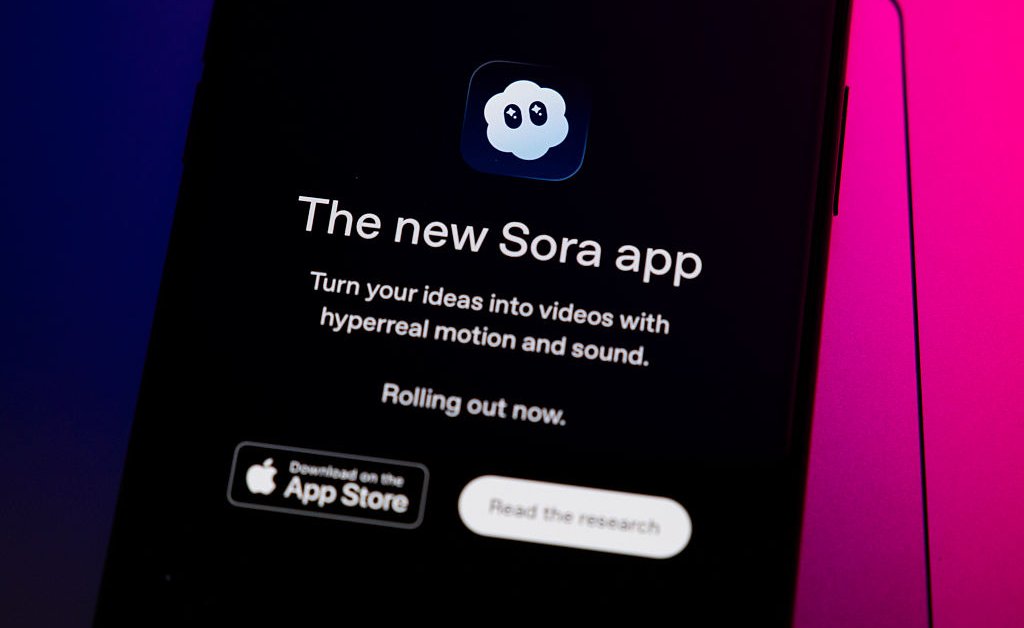OpenAI’s new short-form video app, Sora, seems to have all the ingredients of a viral hit. Just hours after the app’s launch on Tuesday, memes created using its AI video-generation technology were already spreading to other social networks—including, for example, a video of OpenAI CEO Sam Altman rapping from the inside of a toilet bowl.
Sora’s launch—complete with a TikTok style “for you” page—was something of an about-face for Altman, who had previously described social media feeds as “an example of misaligned AI,” whose algorithms “are incredible at getting you to keep scrolling.”
Altman was quick to distance OpenAI from suggestions that it had caved to the temptation to create what he called an AI-powered “slop feed.” He wrote: “The team has put great care and thought into trying to figure out how to make a delightful product that doesn’t fall into that trap, and has come up with a number of promising ideas.”
Still, OpenAI’s decision to launch a short-form video app is a possible sign many tech companies now believe that short-form AI-generated video is a key stepping stone towards developing their goal of artificial general intelligence. Five days before the launch of Sora, Meta launched its own AI-powered short form video app, called Vibes; meanwhile Chinese competitors including TikTok parent ByteDance are competing to claim the frontier of the technology.
AI-generated video is expensive. The AI systems that can generate video are far more energy-intensive than other systems that only output text and images, like ChatGPT.
Nevertheless, OpenAI and Meta seem to now be betting that AI-generated video feeds—although likely loss-making for now—will eventually be a substantial revenue driver. That money may be critical to fund the training of ever-bigger systems that both companies have committed to build.
For OpenAI especially, devising new revenue streams is crucial. Meta already has a highly-profitable business in the form of the targeted ads that it serves via Instagram and Facebook. OpenAI, meanwhile, is unprofitable. Despite its wildly successful product ChatGPT, which brings in more than $1 billion per month, the company spends so heavily on servers and staff that it posted a loss of $7.8 billion in the first half of this year, according to tech news site The Information.
“A lot of the AI game at this point is about growth at all costs—to basically get users, and then figure out how to monetize [them],” says Selina Xu, the China and AI policy lead in the office of former Google CEO Eric Schmidt. “Competition is fierce, so it’s about: ‘Let’s hook people who are not already using Facebook or ChatGPT.’”
There’s also a competitive element to OpenAI’s decision to build not just a viral AI model, but also a means of distribution in the form of a new social media app. In March, the new image generation capabilities of ChatGPT went viral on X and Instagram in a wave of Studio Ghibli-inspired posts. But by creating its own app for Sora, OpenAI now controls the entire user experience. “You deny your competitors the ability to understand what’s driving user behavior, which allows them to build competing products,” says Azeem Azhar, founder of the research group Exponential View.
Read More: How Those Studio Ghibli Memes Are a Sign of OpenAI’s Trump-Era Shift
In addition, short-form video apps may also be a way of collecting data that may be helpful for improving future models, Xu says. “Being able to get a product out first and making it cheap sets off a flywheel: more users use it, more people upload content, [and] your model gets better.”
For now, Sora is free to use, with a higher quality version of the model available to people who pay for ChatGPT Pro. In its launch blog post, OpenAI implied that eventually they would start to charge for access to the free model. OpenAI declined to make a researcher available for an interview to discuss the business strategy behind Sora.
It may not just be about revenue. OpenAI also claims that Sora is a step toward an AI model that can accurately simulate the world. Such a “world simulation” will be “critical for training AI models that deeply understand the physical world,” the company wrote in the blog post announcing the new app.
Azhar is skeptical that Sora 2, the current model powering the new OpenAI app, will be useful for this purpose. But if the company can create an app that attracts hundreds of millions of users today, and then push an even more capable Sora model out via the same app in the future, then the company may have a quick means of collecting multitudes of useful data when its models are capable of generating it, Azhar says.
In a post on X, Altman pushed back against a post that accused him of “launching AI slop videos marketed as personalized ads” instead of building AI to cure cancer. “We do mostly need the capital [to] build AI that can do science, and for sure we are focused on AGI with almost all of our research effort,” he wrote. “It is also nice to show people cool new tech/products along the way, make them smile, and hopefully make some money given all that compute need.”

